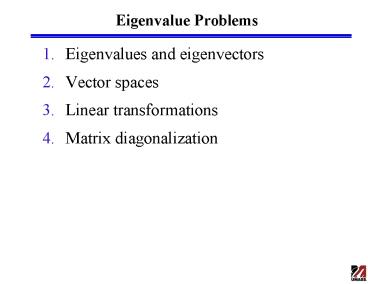Eigenvalue Problems - PowerPoint PPT Presentation
1 / 15
Title: Eigenvalue Problems
1
Eigenvalue Problems
- Eigenvalues and eigenvectors
- Vector spaces
- Linear transformations
- Matrix diagonalization
2
The Eigenvalue Problem
- Consider a nxn matrix A
- Vector equation Ax lx
- Seek solutions for x and l
- l satisfying the equation are the eigenvalues
- Eigenvalues can be real and/or imaginary
distinct and/or repeated - x satisfying the equation are the eigenvectors
- Nomenclature
- The set of all eigenvalues is called the spectrum
- Absolute value of an eigenvalue
- The largest of the absolute values of the
eigenvalues is called the spectral radius
3
Determining Eigenvalues
- Vector equation
- Ax lx ? (A-lI)x 0
- A-lI is called the characteristic matrix
- Non-trivial solutions exist if and only if
- This is called the characteristic equation
- Characteristic polynomial
- nth-order polynomial in l
- Roots are the eigenvalues l1, l2, , ln
4
Eigenvalue Example
- Characteristic matrix
- Characteristic equation
- Eigenvalues l1 -5, l2 2
5
Eigenvalue Properties
- Eigenvalues of A and AT are equal
- Singular matrix has at least one zero eigenvalue
- Eigenvalues of A-1 1/l1, 1/l2, , 1/ln
- Eigenvalues of diagonal triangular matrices are
equal to the diagonal elements - Trace
- Determinant
6
Determining Eigenvectors
- First determine eigenvalues l1, l2, , ln
- Then determine eigenvector corresponding to each
eigenvalue - Eigenvectors determined up to scalar multiple
- Distinct eigenvalues
- Produce linearly independent eigenvectors
- Repeated eigenvalues
- Produce linearly dependent eigenvectors
- Procedure to determine eigenvectors more complex
(see text)
7
Eigenvector Example
- Eigenvalues
- Determine eigenvectors Ax lx
- Eigenvector for l1 -5
- Eigenvector for l1 2
8
Vector Spaces
- Real vector space V
- Set of all n-dimensional vectors with real
elements - Often denoted Rn
- Element of real vector space denoted
- Properties of a real vector space
- Vector addition
- Scalar multiplication
9
Vector Spaces cont.
- Linearly independent vectors
- Elements
- Linear combination
- Equation satisfied only for cj 0
- Basis
- n-dimensional vector space V contains exactly n
linearly independent vectors - Any n linearly independent vectors form a basis
for V - Any element of V can be expressed as a linear
combination of the basis vectors - Example unit basis vectors in R3
10
Inner Product Spaces
- Inner product
- Properties of an inner product space
- Two vectors with zero inner product are called
orthogonal - Relationship to vector norm
- Euclidean norm
- General norm
- Unit vector a 1
11
Linear Transformation
- Properties of a linear operator F
- Linear operator example multiplication by a
matrix - Nonlinear operator example Euclidean norm
- Linear transformation
- Invertible transformation
- Often called a coordinate transformation
12
Orthogonal Transformations
- Orthogonal matrix
- A square matrix satisfying AT A-1
- Determinant has value 1 or -1
- Eigenvalues are real or complex conjugate pairs
with absolute value of unity - A square matrix is orthonormal if
- Orthogonal transformation
- y Ax where A is an orthogonal matrix
- Preserves the inner product between any two
vectors - The norm is also invariant to orthogonal
transformation
13
Similarity Transformations
- Eigenbasis
- If a nxn matrix has n distinct eigenvalues, the
eigenvectors form a basis for Rn - The eigenvectors of a symmetric matrix form an
orthonormal basis for Rn - If a nxn matrix has repeated eigenvalues, the
eigenvectors may not form a basis for Rn (see
text) - Similar matrices
- Two nxn matrices are similar if there exists a
nonsingular nxn matrix P such that - Similar matrices have the same eigenvalues
- If x is an eigenvector of A, then y P-1x is an
eigenvector of the similar matrix
14
Matrix Diagonalization
- Assume the nxn matrix A has an eigenbasis
- Form the nxn modal matrix X with the eigenvectors
of A as column vectors X x1, x2, , xn - Then the similar matrix D X-1AX is diagonal
with the eigenvalues of A as the diagonal
elements - Companion relation XDX-1 A
15
Matrix Diagonalization Example































